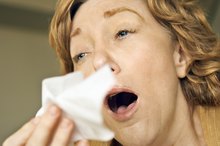What does fact checked mean?
At Healthfully, we strive to deliver objective content that is accurate and up-to-date. Our team periodically reviews articles in order to ensure content quality. The sources cited below consist of evidence from peer-reviewed journals, prominent medical organizations, academic associations, and government data.
- National Heart Lung and Blood Institute: What Is Cough?
- National Heart Lung and Blood Institute: What Is Cough?
The information contained on this site is for informational purposes only, and should not be used as a substitute for the advice of a professional health care provider. Please check with the appropriate physician regarding health questions and concerns. Although we strive to deliver accurate and up-to-date information, no guarantee to that effect is made.
Reflexology to Stop Coughing
Coughing may be attributed to a range of illnesses and causes; just as Western medicine will treat you differently for a common cold or emphysema, reflexology doesn't have a single treatment for coughing. To determine the best care for your condition, first consult with your primary care provider. If you're interested in using reflexology to treat your cough, ask for a recommendation for a qualified practitioner in your area. Depending on your condition, the treatment may ease your cough symptoms or work on the underlying cause.
If you are experiencing serious medical symptoms, seek emergency treatment immediately.
Causes of Coughing
Coughing itself is not a disease, but rather is a symptom connected with many diseases and conditions 1. In some cases, a cough indicates not illness, but your body's defense against an impure environment like a highly dusty room. Coughing is a reflex activity that clears your respiratory system of excess mucus or contagions including smoke. In some cases, coughing may signal a deeper illness 1. Coughs lasting up to three weeks are considered acute, those lasting up to eight weeks are sub-acute, and a cough that lasts more than eight weeks is considered a chronic condition.
How Reflexology Works
About Pressure Points for a Foot Massage
Learn More
Reflexology takes a remarkably different approach to health than Western medicine. Instead of fighting a contagion that causes disease, reflexology aims to restore an energetic flow by restoring balance to 10 zones of the body. A reflexologist applies pressure to specific areas of the feet, hands or ears that correspond with the body's various zones and even to specific organs. By restoring balance, the reflexologist seeks to activate the body's potential for self-healing.
- Reflexology takes a remarkably different approach to health than Western medicine.
- Instead of fighting a contagion that causes disease, reflexology aims to restore an energetic flow by restoring balance to 10 zones of the body.
Foot Reflex Areas for Coughing
Your reflexologist's treatment of your cough will depend largely on your condition's specific details. However, reflexology for frequent coughing likely will involve stimulation of reflex areas on the foot that relate to the respiratory system. On the feet, the lungs, chest and upper back correspond with a large area of the instep, just before the toes, and to the area just beneath on the ball of the foot. In reflexology, sinuses relate to a slender ring around each of the toes, right at the upper joint.
- Your reflexologist's treatment of your cough will depend largely on your condition's specific details.
- However, reflexology for frequent coughing likely will involve stimulation of reflex areas on the foot that relate to the respiratory system.
Hand Reflex Areas for Coughing
Reflexology & Acid Reflux
Learn More
The hands also have reflex areas that correspond with those organs directly used in coughing. For lungs and chest problems, your reflexology may stimulate points along your hands' uppermost edges, just beneath your knuckles. The lower boundary of this lung, chest and breast area is demarcated by a broad curving line that starts close to the first joint of the thumb, where it connects to the hand, and then arches upward, approaching the knuckles.
Related Articles
References
- National Heart Lung and Blood Institute: What Is Cough?
- University of Minnesota: How Does Reflexology Work?
- Lee SH, Kim JY, Yeo S, Kim SH, Lim S. Meta-analysis of massage therapy on cancer pain. Integr Cancer Ther. 2015;14(4):297-304. doi:10.1177/1534735415572885
- National Center for Complementary and Integrative Health. Reflexology. Updated September 24, 2017.
Writer Bio
Danielle Hill has been writing, editing and translating since 2005. She has contributed to "Globe Pequot" Barcelona travel guide, "Gulfshore Business Magazine," "Connecting Lines: New Poetry from Mexico" and "The Barcelona Review." She has trained in neuro-linguistic programming and holds a Bachelor of Arts in comparative literature and literary translation from Brown University.









